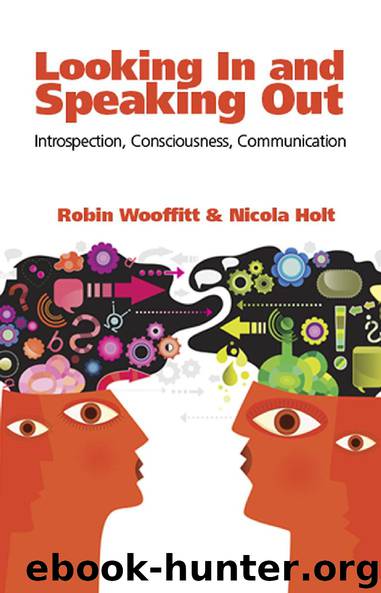Looking In and Speaking Out by Robin Wooffitt & Nicola Holt

Author:Robin Wooffitt & Nicola Holt
Language: eng
Format: epub
Tags: Introspection, consciousness, communication, reporting experience, poetics, mentation narratives, cognitive psycology, relationships, essay
ISBN: 9781845403348
Publisher: Andrews UK Limited 2011
Published: 2011-11-23T00:00:00+00:00
Chapter Six: ‘And the Smell of Death and the Sound of Silence’ - Poetics and Reports of Subjective Experience
In this chapter we examine how mentation narratives display a range of poetical structures and organisations. Our interest in the poetics of introspection stems from the recognition that, on occasions, imagery reports exhibit clearly poetical qualities. For example, the quote in the title of this chapter comes from the following section of a mentation.
(6.1) (01-50: E2/M)
1 (6.9)
2 P: >thinkin- about< (0.3) hu man skeleto :n (3.2) th-
3 sha pe of the ri: bs (2.7) an- how heav y a person is :
4 (4.1)
5 ‘n- the sme ll of death :
6 (4.9)
7 ‘n the sound of si: :le :nce
8 (4.5)
If this were to be reformatted as:
Thinking about [the] human skeleton
The shape of the ribs
And how heavy a person is
And the smell of death
And the sound of silence
...then it could easily be a section of a poem of solemn reflection on corporeality and human mortality.
Although the mentation narratives provide examples of these conventional poetic forms (and, as we shall argue later, some unconventional forms as well), our interest is mainly in how conversational or everyday poetics inform descriptions of conscious imagery. The poetics of everyday discourse refers to a range of phenomena, such as repetitions, puns and other figures of speech (Johnstone, 1987; Lloyd, 2007; Norrik, 2000/2001; Tannen, 1987, 1998; Wales, 2009). In this chapter, though, we are primarily concerned with the range of poetic phenomena first identified by Harvey Sacks in his studies of mundane conversation.
In his published lectures on the organisation of conversational interaction, Sacks examined various data extracts that suggest the operation of turn design procedures that establish poetical relationships. We will discuss three to illustrate the kinds of phenomena he was beginning to notice in his research. Poetic relationships can built from the repetition of particular sounds. For example, Sacks discussed a section of naturally occurring talk in which someone says ‘Oh God! Christmas has gotten so damn painful...no one likes what they’re getting’ (Sacks, 1992, vol. II: 306). He argued that the repetition of the hard ‘g’ sound in ‘God’, ‘gotten’ and ‘getting’ may not be accidental, but the outcome of tacit word selection procedures that display a historical sensitivity to what has come before, or indeed, what might be coming up next. He also discussed data extracts in which word selection may be informed by categorical relationships. For example, in examining a sequence in which a woman remarks on a visit to an empty bar, he focused on her claim ‘God there wasn’t a soul in we were the only ones at the bar’. Sacks noted that the phrase ‘wasn’t a soul’ not only established the emptiness of the bar, but is fitted categorically with the word ‘God’ (and the pun facilitated by the homonymous relationship between ‘soul’ and ‘sole’) (vol. II: 291). Sacks also identified sequences he called reversals, in which particular sound or word sequences seem to be conspicuously inverted to achieve a form of acoustic mirroring.
Download
This site does not store any files on its server. We only index and link to content provided by other sites. Please contact the content providers to delete copyright contents if any and email us, we'll remove relevant links or contents immediately.
| Administration & Medicine Economics | Allied Health Professions |
| Basic Sciences | Dentistry |
| History | Medical Informatics |
| Medicine | Nursing |
| Pharmacology | Psychology |
| Research | Veterinary Medicine |
The Art of Thinking Clearly by Rolf Dobelli(10221)
The 5 Love Languages: The Secret to Love That Lasts by Gary Chapman(9589)
Mindhunter: Inside the FBI's Elite Serial Crime Unit by John E. Douglas & Mark Olshaker(9201)
Becoming Supernatural by Dr. Joe Dispenza(8119)
Nudge - Improving Decisions about Health, Wealth, and Happiness by Thaler Sunstein(7615)
The Road Less Traveled by M. Scott Peck(7522)
Enlightenment Now: The Case for Reason, Science, Humanism, and Progress by Steven Pinker(7235)
Mastermind: How to Think Like Sherlock Holmes by Maria Konnikova(7227)
Win Bigly by Scott Adams(7094)
The Way of Zen by Alan W. Watts(6506)
Factfulness: Ten Reasons We're Wrong About the World – and Why Things Are Better Than You Think by Hans Rosling(4694)
The State of Affairs by Esther Perel(4641)
Gerald's Game by Stephen King(4582)
Man's Search for Meaning by Viktor Frankl(4424)
The Confidence Code by Katty Kay(4187)
Thinking in Bets by Annie Duke(4153)
The Healing Self by Deepak Chopra(3474)
Hidden Persuasion: 33 psychological influence techniques in advertising by Marc Andrews & Matthijs van Leeuwen & Rick van Baaren(3472)
The Worm at the Core by Sheldon Solomon(3435)
